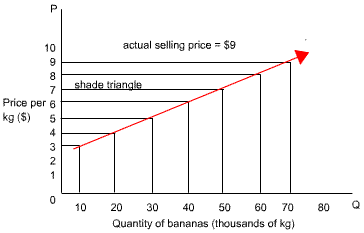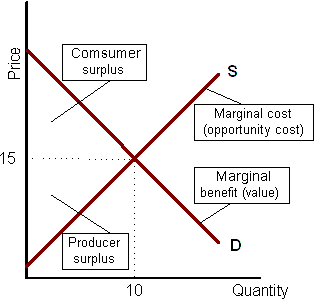Do you want BuboFlash to help you learning these things? Or do you want to add or correct something? Click here to log in or create user.
#cfa #cfa-level-1 #economics #has-images #microeconomics #reading-13-demand-and-supply-analysis-introduction
Producer Surplus


Producer surplus is the difference between the minimum supply price, represented by the supply curve, and the actual sales price.
- It is measured by the area below the price and above the supply curve, up to the quantity sold.
- It accrues to owners of firms and resource suppliers.
Example

The actual selling price of bananas is $9 per kg.
Now imagine that there are only 10,000 kg bananas being supplied at the moment. The marginal cost per kg is only $3 but the selling price is $9. So there is an additional $6 per kg being raised. This is the producer surplus per kg. The total producer surplus when 10,000 kg are produced is thus $60,000.
Due to the surplus, more producers enter the market and another 10,000 kg are produced, so there are now 20,000 kg of bananas on the market. The marginal costs of producing this additional 10,000 kg have risen to $4.
Producer surplus is not the same as profit. Remember that profit is the return that accrues to owners of a firm and is the difference between sales revenue and total (not marginal) costs of production.
Total Surplus
The following figure shows that a competitive market creates an efficient allocation of resources at equilibrium.

- In equilibrium, the quantity demanded equals the quantity supplied.
- At the equilibrium quantity, marginal benefit equals marginal cost, so the quantity is the efficient quantity.
- The sum of consumer and producer surplus is maximized at this efficient level of output. It is here that all potential gains from production and exchange are realized.
If you want to change selection, open document below and click on "Move attachment"
Subject 5. Consumer Surplus, Producer Surplus, and Total Surplus
paid and below the demand curve is called consumer surplus. This area represents the net gains to buyers from market exchange. Lower market prices increase the amount of consumer surplus in the market. <span>Producer Surplus Producer surplus is the difference between the minimum supply price, represented by the supply curve, and the actual sales price. It is measured by the area below the price and above the supply curve, up to the quantity sold. It accrues to owners of firms and resource suppliers. Example The actual selling price of bananas is $9 per kg. Now imagine that there are only 10,000 kg bananas being supplied at the moment. The marginal cost per kg is only $3 but the selling price is $9. So there is an additional $6 per kg being raised. This is the producer surplus per kg. The total producer surplus when 10,000 kg are produced is thus $60,000. Due to the surplus, more producers enter the market and another 10,000 kg are produced, so there are now 20,000 kg of bananas on the market. The marginal costs of producing this additional 10,000 kg have risen to $4. Producer surplus is not the same as profit. Remember that profit is the return that accrues to owners of a firm and is the difference between sales revenue and total (not marginal) costs of production. Total Surplus The following figure shows that a competitive market creates an efficient allocation of resources at equilibrium. In equilibrium, the quantity demanded equals the quantity supplied. At the equilibrium quantity, marginal benefit equals marginal cost, so the quantity is the efficient quantity. The sum of consumer and producer surplus is maximized at this efficient level of output. It is here that all potential gains from production and exchange are realized. <span><body><html>
Subject 5. Consumer Surplus, Producer Surplus, and Total Surplus
paid and below the demand curve is called consumer surplus. This area represents the net gains to buyers from market exchange. Lower market prices increase the amount of consumer surplus in the market. <span>Producer Surplus Producer surplus is the difference between the minimum supply price, represented by the supply curve, and the actual sales price. It is measured by the area below the price and above the supply curve, up to the quantity sold. It accrues to owners of firms and resource suppliers. Example The actual selling price of bananas is $9 per kg. Now imagine that there are only 10,000 kg bananas being supplied at the moment. The marginal cost per kg is only $3 but the selling price is $9. So there is an additional $6 per kg being raised. This is the producer surplus per kg. The total producer surplus when 10,000 kg are produced is thus $60,000. Due to the surplus, more producers enter the market and another 10,000 kg are produced, so there are now 20,000 kg of bananas on the market. The marginal costs of producing this additional 10,000 kg have risen to $4. Producer surplus is not the same as profit. Remember that profit is the return that accrues to owners of a firm and is the difference between sales revenue and total (not marginal) costs of production. Total Surplus The following figure shows that a competitive market creates an efficient allocation of resources at equilibrium. In equilibrium, the quantity demanded equals the quantity supplied. At the equilibrium quantity, marginal benefit equals marginal cost, so the quantity is the efficient quantity. The sum of consumer and producer surplus is maximized at this efficient level of output. It is here that all potential gains from production and exchange are realized. <span><body><html>
Summary
| status | not read | reprioritisations | ||
|---|---|---|---|---|
| last reprioritisation on | suggested re-reading day | |||
| started reading on | finished reading on |
Details
Discussion
Do you want to join discussion? Click here to log in or create user.